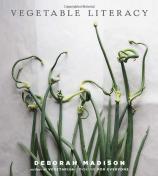BKMT READING GUIDES
Vegetable Literacy: Cooking and Gardening with Twelve Families from the Edible Plant Kingdom, with over 300 Deliciously Simple Recipes
by Deborah Madison
Hardcover : 416 pages
0 club reading this now
0 members have read this book
Introduction
In her latest cookbook, Deborah Madison, America's leading authority on vegetarian cooking and author of Vegetarian Cooking for Everyone, reveals the surprising relationships between vegetables, edible flowers, and herbs within the same botanical families, and how understanding these connections can help home cooks see everyday vegetables in new light.
For over three decades, Deborah Madison has been at the vanguard of the vegetarian cooking movement, authoring classic books on the subject and emboldening millions of readers to cook simple, elegant, plant-based food.
This groundbreaking new cookbook is Madison’s crowning achievement: a celebration of the diversity of the plant kingdom, and an exploration of the fascinating relationships between vegetables, edible flowers, herbs, and familiar wild plants within the same botanical families.
Destined to become the new standard reference for cooking vegetables, Vegetable Literacy shows cooks that, because of their shared characteristics, vegetables within the same family can be used interchangeably in cooking. It presents an entirely new way of looking at vegetables, drawing on Madison’s deep knowledge of cooking, gardening, and botany. For example, knowing that dill, chervil, cumin, parsley, coriander, anise, lovage, and caraway come from the umbellifer family makes it clear why they’re such good matches for carrots, also a member of that family. With more than 300 classic and exquisitely simple recipes, Madison brings this wealth of information together in dishes that highlight a world of complementary flavors. Griddled Artichokes with Tarragon Mayonnaise, Tomato Soup and Cilantro with Black Quinoa, Tuscan Kale Salad with Slivered Brussels Sprouts and Sesame Dressing, Kohlrabi Slaw with Frizzy Mustard Greens, and Fresh Peas with Sage on Baked Ricotta showcase combinations that are simultaneously familiar and revelatory.
Inspiring improvisation in the kitchen and curiosity in the garden, Vegetable Literacy—an unparalleled look at culinary vegetables and plants—will forever change the way we eat and cook.
Editorial Review
Featured Recipe from Vegetable Literacy: Ivory Carrot Soup with a Fine Dice of Orange Carrots

Serves 4-6
Ingredients
- 1 tablespoon butter
- 1 tablespoon olive oil
- 1 onion, thinly sliced
- 1 pound white carrots, scrubbed and thinly sliced
- 1 tablespoon raw white rice
- Sea salt
- 1/2 teaspoon sugar
- 1 thyme sprig
- 4 cups water or light chicken stock
- Few tablespoons finely diced orange carrots and/or other colored carrots
- Freshly ground pepper
- About 1 tablespoon minced fine green carrot tops
Directions
Warm the butter and oil in a soup pot and add the onion, white carrots, rice, 1 teaspoon salt, and the sugar and thyme. Cook over medium heat for several minutes, turning everything occasionally. Add 1 cup of the water, cover, turn down the heat, and cook while you heat the remaining 3 cups water. When the water is hot, add it to the pot, cover, and simmer until the vegetables are tender, about 20 minutes.
While the soup is cooking, cook the diced carrots in salted boiling water for about 3 minutes and then drain.
When ready, let cool slightly, then remove and discard the thyme sprig. Puree the soup until smooth in a blender. Taste for salt and season with the pepper. Reheat if it has cooled.
Ladle the soup into bowls, scatter the diced carrots and carrot tops over each serving, and serve.
Featured Recipe from Vegetable Literacy: Peas with Baked Ricotta and Bread Crumbs

Serves 2
Ingredients
- Olive oil
- 1 cup high-quality ricotta cheese, such as hand-dipped full-fat ricotta
- 2 to 3 tablespoons fresh bread crumbs
- 4 teaspoons butter
- 2 large shallots or 1/2 small onion, finely diced (about 1/3 cup)
- 5 small sage leaves, minced (about 1 1/2 teaspoons)
- 1 1/2 pounds pod peas, shucked (about 1 cup)
- Grated zest of 1 lemon
- Sea salt and freshly ground pepper
- Chunk of Parmesan cheese, for grating
Directions
Heat the oven to 375°F. Lightly oil a small baking dish; a round Spanish earthenware dish about 6 inches across is perfect for this amount.
If your ricotta is wet and milky, drain it first by putting it in a colander and pressing out the excess liquid. Pack the ricotta into the dish, drizzle a little olive oil over the surface, and bake 20 minutes or until the cheese has begun to set and brown on top. Cover the surface with the bread crumbs and continue to bake until the bread crumbs are browned and crisp, another 10 minutes. (The amount of time it takes for ricotta cheese to bake until set can vary tremendously, so it may well take longer than the times given here, especially if it wasnâ??t drained.)
When the cheese is finished baking, heat the butter in a small skillet over medium heat. When the butter foams, add the shallots and sage and cook until softened, about 3 minutes. Add the peas, 1/2 cup water, and the lemon zest. Simmer until the peas are bright green and tender; the time will vary, but it should be 3 to 5 minutes. Whatever you do, donâ??t let them turn gray. Season with salt and a little freshly ground pepper, not too much.
Divide the ricotta between 2 plates. Spoon the peas over the cheese. Grate some Parmesan over all and enjoy while warm.
With Pasta: Cook 1 cup or so pasta shells in boiling, salted water. Drain and toss them with the peas, cooked as above, and then with the ricotta. The peas nestle in the pasta, like little green pearls.
Discussion Questions
No discussion questions at this time.Book Club Recommendations
Recommended to book clubs by 0 of 0 members.
Book Club HQ to over 88,000+ book clubs and ready to welcome yours.
Get free weekly updates on top club picks, book giveaways, author events and more








